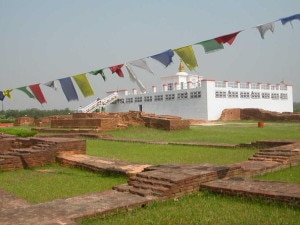Archaeologists dig out findings about Buddha's birth place

KATHMANDU, Nepal-A team of Nepali and foreign archaeologists has found out traces of a temple that is associated with Lord Buddha’s birth event that went back to the 6th century B.C.
At a time neighboring India is spreading wrong information about Buddha’s birth place to lure millions of tourist there, a team of researchers, led by Durham University’s archaeologist Robin Coningham in North East England and Kosh Prasad Acharya of the Pashupati Area Development Trust in Nepal succeeded to dig out the findings about the birth place of Buddha who was born as Siddhartha Gautama in Lumbini, westerrn Nepal.
They reached near the truth after excavating the remainders of a timber like structure at the Maya Devi Temple and have published the findings on a journal Antiquity on Monday.
The story of the new discovery will be featured in a National Geographic documentary in February, it is learnt.
‘Very little is known about the life of the Buddha, except through textual sources and oral tradition,’ Coningham said after accomplishing the excavation.
The team has mentioned various dates for Buddha’s birt: ranging from the third to the eighth century B.C. However, it is generally accepted that Buddha was born in the 6th century BC.
Minister for Culture, Tourism and Civil Aviation Ram Kumar Shrestha said the findings bear very significant to better understand the birthplace of the Lord Buddha who founded the Buddism. ‘The government of Nepal will leave no stone unturned to preserve this religious site,’ Minister Shrestha said.
Archaeologists in Nepal believed that the fresh evidence would support experts to elaborate the historical background for Buddha, who scattered his teaching across the world, apart from erasing the rumors on the birth place of Buddha as created by India. Some Indian government agency is still making baseless statement that he was born in Orissa.
According to them, the finding is also likely to boost Lumbini from archaeological, religious and tourism perspectives besides its historical value.
Lumbini has already been enlisted in UNESCO World Heritage Site, and nearly a million pilgrims mostly from Buddhist nations pay visit the site every year. The government of Nepal is planning to set up international airport in Lumbini evaluating the increased flow of tourists there.
According to Coningham, the period at which he was born was actually a period of dramatic change- a time marked by urbanization and the rise of a merchant class in the region.
Starting in 2011team leader Coningham along with Nepali team member Acharya and their colleagues detailed the design of a temple which is believed to made in the third century B.C., during the time of Emperor Ashoka.
Beneath that temple, they found the massive bricks of yet another temple that was also built in the same period.
The temples’ foundation stones hinted that there was a central area that was left open to the sky. When the archaeologists excavated that area, they found an arrangement of postholes shaping an enclosure — and within that enclosure; they found the remains of tree roots.

